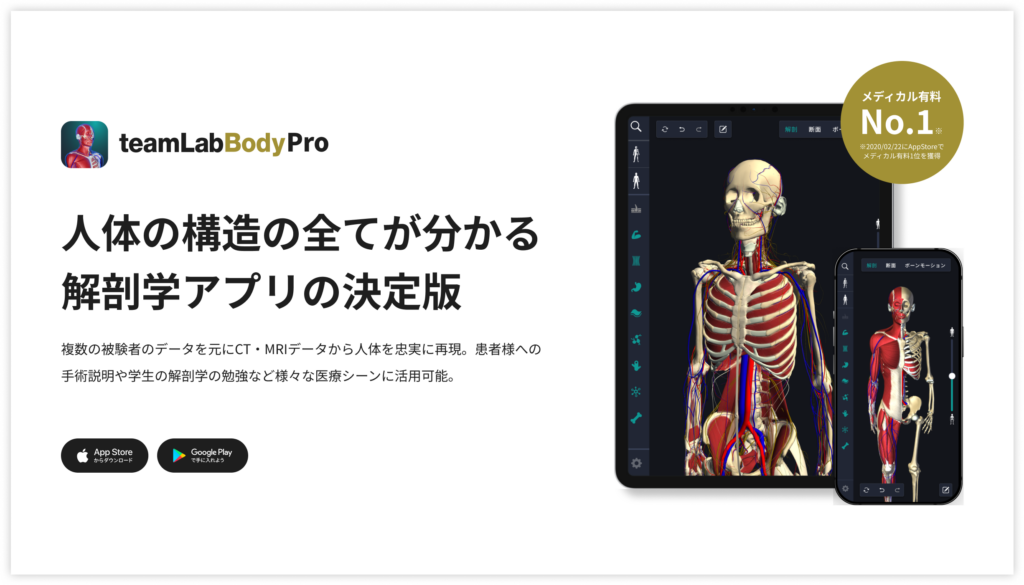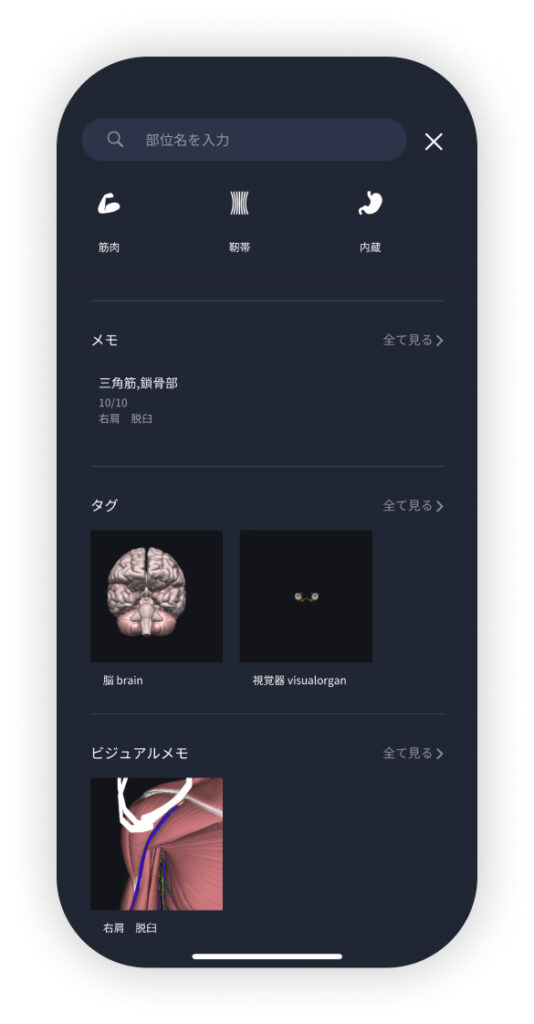beginning
In this article, I will explain effective study methods, starting with knowledge of specialized parts in human anatomy.
In human anatomy, it is necessary not only to memorize the names of various organs, muscles, and bones, but also to remember where they are located in the body. Therefore, it is necessary to learn as efficiently as possible.
I hope you will deepen your understanding even a little by reading this article and using the app.
Now, I'll explain the details about the “serratus superior and posterior muscle” and how to study human anatomy.
teamLab Body Pro Free Download
A 3D anatomy app that shows all the structures of the human body
Download teamLab Body Pro here!

What is serratus superior posterior muscle?
The anatomy application allows you to view a selection of anatomy 3D models. In this model, there are various observation methods such as surfaces, cross-sections, and nervous systems. This time, I'll explain using an anatomy application.
About serratus superior posterior muscle

The serratus posterior superior muscle (serratus posterior superior) is a thin muscle located deep in the back that starts at the spines of the 6th to 7th cervical vertebrae and 1st to 2nd thoracic vertebrae and stops at the upper edge of the 2nd to 5th ribs.
This muscle is mainlyPull your ribs up when you inhaleIt works as a breathing aid muscle. It works on the upper part of the rib cage and helps the lungs expand, enabling deep breathing.
Since it looks like it is in the deep layer of the latissimus dorsi muscle, it is a muscle that is difficult to observe from a normal surface, but it is an important structure for understanding the physiological mechanism of breathing.
Furthermore, the serratus superior posterior muscle cooperates with other back muscles via fascia, and is thought to be involved in maintaining posture and stabilizing the upper back.
Study points
Anatomical understanding: understanding the relationship between start/stop and position
The serratus posterior superior muscle is a deep muscle in the back and lies further behind the trapezius and latissimus dorsi muscles. The beginning is the spiny process of the 6th to 7th cervical vertebrae and the 1st to 2nd thoracic vertebra, and the stop is the 2nd to 5th ribs, and it runs in such a way that the ribs are pulled up diagonally.
Since this muscle is extremely thin and overlaps with other back muscles, it is effective to visually learn the three-dimensional positional relationship with surrounding structures using a 3D anatomy application or tomogram. In particular, by suppressing relationships with latissimus dorsi muscles, trapezius muscles, and spinal standing muscles, it also leads to understanding functional linkage and fascial connectivity.
Functional understanding: learning in relation to breathing
The serratus superior and posterior muscles act as breathing aids, so feeling their movement is the key to deepening understanding. By being aware of the feeling that your upper back moves slightly when you take a deep breath, you can experience the function of this muscle.
In particular, in conjunction with learning the respiratory system, “Why are back muscles involved in intake?” If you learn from that point of view, your understanding will deepen. Also, by performing a functional contrast with the serratus posterior inferior muscle (superior posterior serratus muscle = intake, lower posterior serratus muscle = exhalation), it is easier to sort out the role of the muscle.
Practical application: understanding clinical and operational applications
The serratus superior posterior muscle is a muscle that is not often noticed in everyday life, but it has been pointed out that it is related to breathing disorders and shoulder girdle stiffness. In particular, if you continue to slouch or breathe shallowly, this muscle is likely to be overstrained, which may lead to back tension and stiff shoulders as a result.
Also, in respiratory rehabilitation and bodywork (Pilates, yoga, etc.), this muscle movement is sometimes attracting attention for the purpose of increasing rib cage mobility. By working on practical learning that links posture and breathing, you can develop more practical application skills.
How to study human anatomy
I will explain specific study methods using human anatomy applications.
Check your past learning history and practice repeatedly
Here are the steps to check your anatomy learning history and practice iteratively effectively.
1. Check your learning history in the app
Reviewing your learning history with the application is an important step in effectively advancing anatomy learning. First, launch the app and go to the learning history section from the main menu. Many anatomy apps are designed to show your progress in the form of graphs and lists, so you can visually check which parts you've learned about and how much time you've spent.
By using this data, you can understand which areas you have strengths in and where you need to spend more time and effort. We also recommend using a dedicated tag or notebook function to mark areas you are particularly weak at or where you need to relearn. Regularly checking your learning history and looking back on past learning content will lead to efficient review and deepening understanding.
2.Make a plan for iterative learning
Making an efficient repetitive learning plan based on learning history is extremely effective in promoting knowledge retention. First, identify weak points and areas where you need to relearn. Next, arrange these study items into a weekly or monthly calendar and create a specific study schedule. By proceeding in a planned manner, you can learn each part evenly and avoid packing in a large amount of information at once.
Using a task management app or digital calendar to set study reminders is effective. Also, it's important to have the flexibility to regularly review progress and revise plans as needed. By having goals and proceeding with your studies in a planned manner, you can efficiently acquire anatomical knowledge.
3.Use 3D features to learn visually
By utilizing the 3D function, learning anatomy is easier to understand visually. The 3D model shows the structure of the human body three-dimensionally, and each part can be observed in detail. This makes it possible to intuitively grasp positional relationships between deep muscles and organs that are difficult to capture in a planar view. For example, you can learn even the smallest details by rotating specific muscles and bones and zooming in and out.
Also, there are many apps that have the function of displaying cross-sectional views of each part using a 3D model, which is useful for deepening understanding of internal structures. This diversity of visual information helps with memory retention and improves immediate responsiveness in tests and practice situations. By utilizing the 3D function and learning visually, you can learn anatomy knowledge more deeply and efficiently.
Use the memo function concretely

Make notes so you don't forget the things and points you've noticed while studying. The memo function can be used for different purposes, such as inputting text, saving images, and writing memos. Tag your notes to make them easier to review later.
Test your learning regularly in the form of quizzes
Regularly testing what you've learned in a quiz format is a very effective way to anchor your anatomy knowledge. Quiz-style tests help you objectively grasp your level of understanding and areas you lack while repeating knowledge.
For example, by using a learning app to conduct quizzes every specific period, you can reconfirm what you've learned and strengthen your memory. There are a wide range of quiz formats, such as multiple choice questions, fill-in-the-blank questions, and short answer questions, and each helps understanding from a different angle and develops the ability to utilize various types of knowledge.
Get feedback
If possible, get feedback from other learners and experts. It helps you find your own gaps in understanding and areas for improvement. You can also keep yourself motivated to learn by regularly testing yourself. Feeling a sense of accomplishment and progress increases motivation for continuous learning.
summary
This time, I explained how to study the “serratus superior and posterior muscle” using an application!
Thank you for reading this far.
I would be happy if reading this article helped you learn about anatomy.
Learning is a long, never-ending journey, but I sincerely wish you all the best. Let's continue to study together and work hard for the national exam!
Please look forward to the next blog.
teamLab Body Pro Free Download
A 3D anatomy app that shows all the structures of the human body
Download teamLab Body Pro here!





